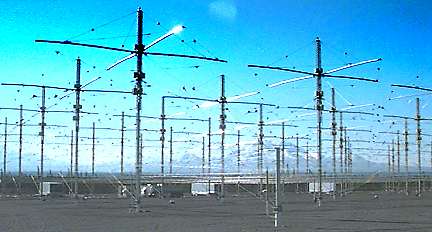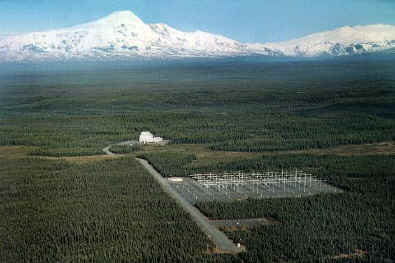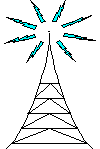HAARP


HAARP stands for High Frequency Active Auroral Research Program (HAARP) which is an investigation project to "understand, simulate and control ionospheric processes that might alter the performance of communication and surveillance systems". Started in 1993, the project is proposed to last for a period of twenty years.
The project is jointly funded by US Air Force, Navy, and University of Alaska. It is said that the project is similar to numerous existing ionospheric heaters around the world, and has a large suite of diagnostic instruments that facilitate its use to increase scientific understanding of ionospheric dynamics. Though many have expressed fears of HAARP being used as a nefarious weapon, the scientists involved in aeronomy, space science, or plasma physics dismiss these fears as unfounded.
The HAARP Site in Alaska
The project site is near Gakona, Alaska (lat. 62.39ƒ N, long 145.15 W), just West of the Wrangell-Saint Elias National Park. An environmental impact statement led to permission for an array of up to 180 antennas to be erected. HAARP has been constructed at the previous site of an over-the-horizon radar installation.
A large structure, built to house the OTH now houses the HAARP control room, kitchen, and offices. Several other small structures house various instruments. The Ionospheric Research Instrument (IRI) is the primary instrument at HAARP, which is a high-frequency (HF) transmitter system used to temporarily modify the ionosphere.
Study of this modified volume yields important information for understanding natural ionospheric processes.During active ionospheric research, the signal generated by the transmitter system is delivered to the antenna array, transmitted in an upward direction, and is partially absorbed, at an altitude between 100 to 350 km (depending on operating frequency), in a small volume a few hundred meters thick and a few tens of kilometers in diameter over the site.
The intensity of the HF signal in the ionosphere is less than 3 microwatts per cm2, tens of thousands of times less than the Sun's natural electromagnetic radiation reaching the earth and hundreds of times less than even the normal random variations in intensity of the Sun's natural ultraviolet (UV) energy which creates the ionosphere.
The small effects that are produced, however, can be observed with the sensitive scientific instruments installed at the HAARP facility and these observations can provide new information about the dynamics of plasmas and new insight into the processes of solar-terrestrial interactions.
The HAARP site has been constructed in three distinct phases.
The Developmental Prototype (DP) had 18 antenna elements, organized in three columns by six rows. It was fed with a total of 360 kilowatts (KW) combined transmitter output power. The DP transmitted just enough power for the most basic of ionospheric testing.
The Filled Developmental Prototype (FDP) had 48 antenna units arrayed in six columns by eight rows, with 960 KW of transmitter power. It was fairly comparable to other ionospheric heating facilities. This was used for a number of successful scientific experiments and ionospheric exploration campaigns over the years.
The Final IRI (FIRI) will be the final build of the IRI. It has 180 antenna units, organized in 15 columns by 12 rows, yielding a theoretical maximum gain of 31 dB. A total of 3600 KW (3.6 MW) of transmitter power will feed it. The total effective radiated power (ERP) will be 3,981 MW (96 dBW).
As of the summer of 2005, all the antennas were in place, but the final quota of transmitters had not yet been installed.Each antenna element consists of a crossed dipole that can be polarized for linear, ordinary mode (O-mode), or extraordinary mode (X-mode) transmission and reception.
Each part of the two section crossed dipoles are individually fed from a custom built transmitter, that has been specially designed with very low distortion. The ERP of the IRI is limited by more than a factor of 10 at its lower operating frequencies.
Much of this is due to higher antenna losses and a less efficient antenna pattern.
HAARP can transmit between 2.8 and 10 MHz. This frequency range lies above the AM radio broadcast band and well below Citizens' Band frequency allocations.
HAARP is only licensed to transmit in certain segments of this frequency range, however.
When the IRI is transmitting, the bandwidth of the transmitted signal is 100 kHz or less. The IRI can transmit continuously (CW) or pulses as short as 100 microseconds. CW transmission is generally used for ionospheric modification, while short pulses are frequently repeated, and the IRI is used as a radar system.
Researchers can run experiments that use both modes of transmission, modifying the ionosphere for a predetermined amount of time, then measuring the decay of modification effects with pulsed transmissions.
Stated objectives
The HAARP project aims to direct a 3.6 MW signal, in the 2.8-10 MHz region of the HF band, into the ionosphere. The signal may be pulsed or continuous wave. Then effects of the transmission and any recovery period will be examined associated instrumentation, including VHF and UHF radars, HF receivers, and optical cameras.
According to the HAARP team, this will advance the study of basic natural processes that occur in the ionosphere under the natural but much stronger influence of solar interaction, as well as how the natural ionosphere affects radio signals.
This will enable scientists to develop techniques to mitigate these effects in order to improve the reliability and/or performance of communication and navigation systems, which would have a wide range of applications in both the civilian and military sectors.
The project is funded by the Office of Naval Research and jointly managed by the ONR and Air Force Research Laboratory, with the principal involvement of the University of Alaska. Fourteen other universities and educational institutions have been involved in the development of the project and its instruments, namely the University of Alaska, Penn State University (ARL), Boston College, UCLA, Clemson University, Dartmouth College, Cornell University, Johns Hopkins University, University of Maryland, College Park, University of Massachusetts, MIT, Polytechnic University, Stanford University, and the University of Tulsa.
The project's specifications were developed by the universities, which are continuing to play a major role in the design of future research efforts. There is both military and commercial interest in its outcome, as many communications and navigation systems depend on signals being reflected from the ionosphere or passing through the ionosphere to satellites.
The HAARP project offers annual open days to permit the general public to visit the facility, and makes a public virtue of openness; according to the team, "there are no classified documents pertaining to HAARP."
Each summer, HAARP holds a summer-school for visiting students, giving them an opportunity to do research with one of the world's foremost research instruments.
HAARP controversy
Numerous parties have found reasons to suspect that HAARP is more than the government claims it to be. Various theories draw on brain waves, confusion of the ionosphere with the neutral atmosphere, and over-stated claims of HAARP supporters. Many of the concerns about HAARP have been presented so as to be dismissed as "conspiracy theories" by some, while seen as proof of nefarious governmental plotting by others.
HAARP's Critics
Waste:
The cost of building HAARP has exceeded the dollar-adjusted cost of similar facilities around the world. HAARP was constructed at the site of an obsoleted over-the-horizon radar facility for political reasons, but its location was less than ideal from a scientific perspective. Some believe that it was constructed as a pork barrel project for Alaska by Senator Ted Stevens.
Weapon:
The objectives of the HAARP project became the subject of controversy in the mid-1990s, following claims that the antennas could be used as a weapon. A small group of American physicists aired complaints in scientific journals such as Physics and Society, charging that HAARP could be seeking ways to blow other countries' spacecraft out of the sky or disrupt communications over large portions of the planet. The physicist critics of HAARP have had little complaint about the project's current stage, but have expressed fears that it could in future be expanded into an experimental weapon.
These concerns were amplified by Bernard Eastlund, a physicist who developed some of the concepts behind HAARP in the 1980s and proposed using high-frequency radio waves to beam large amounts of power into the ionosphere, energizing its electrons and ions in order to disable incoming missiles and knock out enemy satellite communications. The US military became interested in the idea as an alternative to the laser-based Strategic Defense Initiative.
However, Eastlund's ideas were eventually dropped as SDI itself mutated into the more limited National Missile Defense of today. The contractors selected to build HAARP have denied that any of Eastlund's patents were used in the development of the project.After the physicists raised early concerns, the controversy was stoked by local activism.
In September 1995, a book entitled Angels Don't Play This HAARP: Advances in Tesla Technology by Nick Begich, Jr., son of the late Congressman Nick Begich, claimed that the project in its present stage could be used for "geophysical warfare".
HAARP has subsequently become a target for those who have suggested that it could be used to test the ability "to deliver very large amount of energy, comparable to a nuclear bomb, anywhere on earth", "changing weather patterns", "blocking all global communications", "disrupting human mental processes" and mind control, communicating with submarines, and "x-raying the earth".
In April 1997, the then U.S. Secretary of Defense William Cohen publicly discussed the dangers of HAARP-like technology, saying "others are engaging even in an eco-type of terrorism whereby they can alter the climate, set off earthquakes, volcanoes remotely through the use of electromagnetic waves... So there are plenty of ingenious minds out there that are at work finding ways in which they can wreak terror upon other nations... It's real, and that's the reason why we have to intensify our efforts."
This quote derives from an April 1997 counterterrorism conference sponsored by former Senator Sam Nunn, quoted from "DoD News Briefing, Secretary of Defense William S. Cohen, Q&A at the Conference on Terrorism, Weapons of Mass Destruction, and U.S. Strategy," held at the University of Georgia-Athens, Apr. 28, 1997.
Russians - In August 2002, further support for those critical of HAARP technology came from the State Duma (parliament) of Russia. The Duma published a critical report on HAARP written by the international affairs and defense committees, signed by 90 deputies and presented to President Vladimir Putin. The report claimed that "the U.S. is creating new integral geophysical weapons that may influence the near-Earth medium with high-frequency radio waves ... The significance of this qualitative leap could be compared to the transition from cold steel to fire arms, or from conventional weapons to nuclear weapons. This new type of weapons differs from previous types in that the near-Earth medium becomes at once an object of direct influence and its component." However, given the timing of the Russian intervention, it is likely that it was related to a controversy at the time concerning the US withdrawal in June 2002 from the Russian-American Anti-Ballistic Missile Treaty.
This high level concern is paralled in the April 1997 statement by the U.S. Secretary of Defense over the power of such electromagnetic weaponry. Russia owns an ionospheric heater as powerful as HAARP, called 'Sura,' which is located in central Russia, roughly 150 km from the city of Nizhny Novgorod.
HAARP's supporters
The critics' views have been rejected by HAARP's defenders, who have pointed out that the amount of energy at the project's disposal is minuscule compared to the colossal energies dumped into the atmosphere by solar radiation and thunderstorms. A University of Alaska, Geophysical Institute scientist has compared HAARP to an "immersion heater in the Yukon River."
It would also be unable to effect any long-lasting changes; as the ionosphere is inherently a chaotically turbulent region, any artificially induced changes would be "swept clean" within seconds or minutes at the most. Ionospheric heating experiments performed at the Arecibo Observatory's ionospheric heater and incoherent scatter radar have shown that no matter how long the ionosphere is modified, it returns to normal within the same period of time.
Ionospheric heating cannot be performed while the sun illuminates the ionosphere for two reasons:Solar UV creates the ionospheric D-region, which absorbs the radio waves used for ionospheric heating.
The solar flux overwhelms any effect of ionospheric heating. (needs to be verified John Elder 01:50, 13 Jun 2005 (UTC))HAARP's supporters also point to the lack of serious scientific evidence to support some of the more exotic claims being made about HAARP, such as the conjecture that the system caused the 2003 North America blackout or earthquakes.
Most scientists reject the extreme criticism of HAARP as "utter nonsense," especially aeronomers and space-physicists who have a solid understanding of the accusations levelled at HAARP.
Books, such as Angel's don't Play this HAARP, are often circulated and ridiculed in private. The scientific community puts forth little or no effort to defend HAARP, because they perceive those who attack HAARP as lacking sufficient understanding of science to criticize HAARP competently.

HAARP HOME PAGE
ALPHABETICAL INDEX OF ALL FILES
CRYSTALINKS MAILING LIST, NEWSLETTER, UPDATES



No comments:
Post a Comment